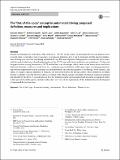| dc.contributor.author | Merat, Natasha | |
| dc.contributor.author | Louw, Tyron | |
| dc.contributor.author | Engström, Johan | |
| dc.contributor.author | Lee, John D | |
| dc.contributor.author | Johansson, Emma | |
| dc.contributor.author | Green, Charles A | |
| dc.contributor.author | Katazaki, Satoshi | |
| dc.contributor.author | Monk, Chris | |
| dc.contributor.author | Itoh, Makoto | |
| dc.contributor.author | McGehee, Daniel | |
| dc.contributor.author | Sunda, Takashi | |
| dc.contributor.author | Unoura, Kiyozumi | |
| dc.contributor.author | Victor, Trent | |
| dc.contributor.author | Schieben, Anna | |
| dc.contributor.author | Keinath, Andreas | |
| dc.contributor.author | Bredfeldt, Bobbie | |
| dc.date.accessioned | 2018-09-18T13:41:59Z | |
| dc.date.available | 2018-09-18T13:41:59Z | |
| dc.date.issued | 2018-09 | |
| dc.date.submitted | 2018-04 | |
| dc.identifier.issn | 1435-5558 | |
| dc.identifier.issn | 1435-5566 | |
| dc.identifier.uri | http://hdl.handle.net/1721.1/118125 | |
| dc.description.abstract | Despite an abundant use of the term “Out of the loop” (OOTL) in the context of automated driving and human factors research, there is currently a lack of consensus on its precise definition, how it can be measured, and the practical implications of being in or out of the loop during automated driving. The main objective of this paper is to consider the above issues, with the goal of achieving a shared understanding of the OOTL concept between academics and practitioners. To this end, the paper reviews existing definitions of OOTL and outlines a set of concepts, which, based on the human factors and driver behaviour literature, could serve as the basis for a commonly-agreed definition. Following a series of working group meetings between representatives from academia, research institutions and industrial partners across Europe, North America, and Japan, we suggest a precise definition of being in, out, and on the loop in the driving context. These definitions are linked directly to whether or not the driver is in physical control of the vehicle, and also the degree of situation monitoring required and afforded by the driver. A consideration of how this definition can be operationalized and measured in empirical studies is then provided, and the paper concludes with a short overview of the implications of this definition for the development of automated driving functions. | en_US |
| dc.description.sponsorship | European Commission (FP7 and H2020 Projects VRA AND CARTRE) | en_US |
| dc.publisher | Springer London | en_US |
| dc.relation.isversionof | https://doi.org/10.1007/s10111-018-0525-8 | en_US |
| dc.rights | Creative Commons Attribution | en_US |
| dc.rights.uri | http://creativecommons.org/licenses/by/4.0/ | en_US |
| dc.source | Springer London | en_US |
| dc.title | The “Out-of-the-Loop” concept in automated driving: proposed definition, measures and implications | en_US |
| dc.type | Article | en_US |
| dc.identifier.citation | Merat, Natasha, Bobbie Seppelt, Tyron Louw, Johan Engström, John D. Lee, Emma Johansson, Charles A. Green, et al. “The ‘Out-of-the-Loop’ Concept in Automated Driving: Proposed Definition, Measures and Implications.” Cognition, Technology & Work (September 15, 2018). | en_US |
| dc.contributor.department | Massachusetts Institute of Technology. Center for Transportation & Logistics | en_US |
| dc.contributor.mitauthor | Bredfeldt, Bobbie | |
| dc.relation.journal | Cognition, Technology & Work | en_US |
| dc.eprint.version | Final published version | en_US |
| dc.type.uri | http://purl.org/eprint/type/JournalArticle | en_US |
| eprint.status | http://purl.org/eprint/status/PeerReviewed | en_US |
| dc.date.updated | 2018-09-16T03:19:05Z | |
| dc.language.rfc3066 | en | |
| dc.rights.holder | The Author(s) | |
| dspace.orderedauthors | Merat, Natasha; Seppelt, Bobbie; Louw, Tyron; Engström, Johan; Lee, John D.; Johansson, Emma; Green, Charles A.; Katazaki, Satoshi; Monk, Chris; Itoh, Makoto; McGehee, Daniel; Sunda, Takashi; Unoura, Kiyozumi; Victor, Trent; Schieben, Anna; Keinath, Andreas | en_US |
| dspace.embargo.terms | N | en_US |
| mit.license | PUBLISHER_CC | en_US |
